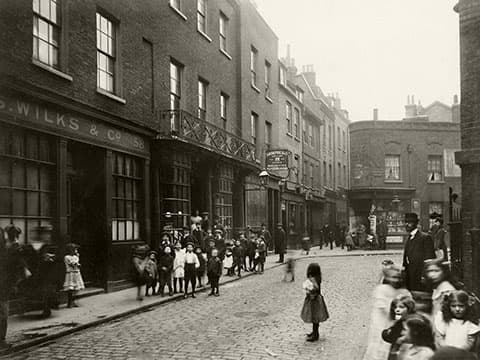Photo: Copyright Bishopsgate Institute
A canny piece of detective work led to the date in April 1912 when Charles Mathew recorded what experts say are rare, spontaneous, vividly engaging photos – recorded in an era when posed images were more common.
The newly restored images, unearthed at the Bishopsgate Institute, are set to go on show at Eleven Spitalfields Gallery from tomorrow.
The gallery paid tribute to Mathew for managing to capture the photos with ‘startling clarity’.
‘In contrast to the more formal, posed photographs of the time [that] viewers may be more familiar with, these photographs engage vividly with a modern audience who see the people, the streets and the everyday details, just as C A Mathew himself would have seen them.’
It is believed that Mathew, who died in 1923, captured the images as he walked the short distance from Liverpool Street Station to Spitalfields on the morning of Saturday 20 April 1912.
Anita Lawlor, director of Eleven Spitalfields Gallery – where the images will be on display until 25 April – explained how a newspaper hoarding in one of the images (see below) helped pinpoint the date they were shot.


Photos: Copyright Bishopsgate Institute
Speaking to Amateur Photographer, Lawlor said that the partially viewable word ‘Titanic’ led researchers to conclude that it must have been taken in the days after the Titanic hit an iceberg on 14 April 1912.
And the way that children are dressed in the photo suggested it was captured on a Saturday, during the Sabbath, the Jewish holy day.

The street in Spitalfields as it appears today [Photo credit: Google Street View]
‘It’s a really wonderful image, not only for unlocking the mystery of the date the images were taken but for anyone who knows the area of Spitalfields, this street corner is virtually unchanged.
‘Of all the 21 images in the exhibition, its location is instantly recognisable.’
The images were restored from high-resolution scans of prints, as the orginal 5x4in plates did not survive, added Lawlor.
Charles Mathew was married and in his 40s when he switched career, according to newly uncovered research by Vicky Stewart, published on Tuesday.
In 1910 he left his job as a clerk for the district surveyor in Walthamstow to become a self-employed photographer, moving to Brightlingsea, Essex soon after.

Photo: Copyright Bishopsgate Institute








